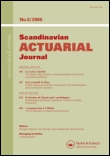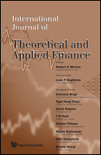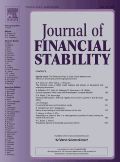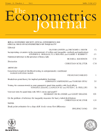
Journal of Financial Econometrics
Scope & Guideline
Unveiling the complexities of financial markets through rigorous analysis.
Introduction
Aims and Scopes
- Empirical Asset Pricing:
Research that examines the relationship between asset prices and their fundamental determinants, utilizing various econometric techniques to test asset pricing models. - Risk Modeling and Management:
Papers focusing on the estimation and management of financial risk, including methodologies for forecasting volatility and assessing systemic risk. - High-Dimensional Data Analysis:
Studies that explore portfolio selection and estimation techniques in high-dimensional settings, often employing advanced statistical methods to handle large datasets. - Dynamic Models and Time Series Analysis:
Research utilizing dynamic models to analyze time series data, addressing issues such as non-stationarity, structural breaks, and regime changes. - Machine Learning Applications in Finance:
The application of machine learning techniques to financial data analysis, enhancing predictive accuracy and modeling capabilities in various financial contexts. - Factor Models and Covariance Estimation:
Development and application of factor models for understanding asset returns and estimating covariance matrices, crucial for portfolio optimization.
Trending and Emerging
- Machine Learning and AI in Finance:
An increasing number of papers are exploring the applications of machine learning and artificial intelligence in financial forecasting, risk assessment, and asset pricing, indicating a significant shift towards data-driven approaches. - Volatility Modeling and Forecasting:
Research focusing on advanced methods for modeling and forecasting volatility has surged, reflecting the need for accurate risk measurement in increasingly volatile markets. - Network Analysis in Finance:
There is a growing interest in applying network theory to financial data, allowing for the exploration of complex interdependencies between assets and the systemic risk implications. - Cross-Country Financial Dynamics:
Emerging themes explore the interconnectedness of financial markets across countries, particularly in the context of global economic events and crises. - Nonlinear and Asymmetric Models:
A trend towards utilizing nonlinear and asymmetric models for better capturing the complexities of financial data, particularly in the context of jumps and extreme events.
Declining or Waning
- Traditional Linear Models:
There is a noticeable decline in the use of traditional linear regression models for financial analysis, as researchers increasingly adopt more sophisticated and flexible modeling techniques. - Static Risk Models:
Interest in static risk models has diminished, with a shift towards dynamic and adaptive models that better capture the changing nature of financial markets. - Basic Time Series Analysis:
Standard approaches to time series analysis are being overshadowed by more complex methodologies that account for non-linearities and structural breaks, leading to a reduced focus on classical time series techniques. - Descriptive Studies of Financial Behavior:
Papers that primarily provide descriptive analyses without robust econometric testing are becoming less common, as the demand for rigorous empirical validation increases. - Single-Factor Models:
There is a notable reduction in research centered on single-factor models, with a growing emphasis on multi-factor approaches that provide a more comprehensive view of financial phenomena.
Similar Journals

ECONOMIC MODELLING
Shaping Economic Understanding with Empirical Excellence.ECONOMIC MODELLING, published by Elsevier, is a leading academic journal in the field of Economics and Econometrics, with a commendable impact factor that underscores its significance within the research community. Since its inception in 1984, this journal has been pivotal in disseminating high-quality research that contributes to the advancement of theoretical and empirical methodologies in economics. As a Q1 journal in its category, it ranks in the top 88th percentile according to Scopus, solidifying its reputation as an influential platform for economists and academicians. Although it does not offer open access, the journal maintains a robust subscription model, ensuring wide distribution of critical insights and findings. Researchers, practitioners, and students are encouraged to engage with the latest developments in economic modelling, making ECONOMIC MODELLING an essential resource for anyone seeking to understand and contribute to the evolving landscape of economic theory and application.

Scandinavian Actuarial Journal
Exploring the depths of statistics and probability.The Scandinavian Actuarial Journal, published by Taylor & Francis Ltd, stands as a pivotal resource in the fields of Economics, Econometrics, Statistics, and Probability, with a legacy dating back to 1918. This esteemed journal, headquartered in the United Kingdom, offers valuable insights and comprehensive research findings that contribute significantly to the actuarial and statistical communities. With its impressive 2023 quartile rankings—Q1 in both Statistics and Probability, and in Statistics, Probability and Uncertainty, as well as Q2 in Economics and Econometrics—this journal is recognized for its high-quality peer-reviewed content, making it indispensable for researchers, professionals, and students alike. Although it currently does not operate under an Open Access model, the journal ensures rigorous academic standards and broad visibility within its field. With a Scopus rank placing it in the top quartile of relevant categories, the Scandinavian Actuarial Journal is committed to advancing knowledge and fostering innovation in statistical methodologies and insights.

Pacific-Basin Finance Journal
Exploring Financial Frontiers in the Pacific BasinPacific-Basin Finance Journal is a prestigious academic journal that focuses on critical developments and innovative research within the fields of finance and economics, specifically tailored to the Pacific region's unique economic landscape. Published by Elsevier, the journal boasts an impressive impact factor and is categorized in the Q1 quartile for both Economics and Econometrics and Finance as of 2023. This indicates its high relevance and position among the top journals in its field, with Scopus rankings reflecting a strong standing in the competitive landscape of finance research, holding the 45th position out of 317 in Finance and the 108th in Econometrics. Established in 1993, the journal is committed to disseminating rigorous theoretical and empirical research findings that enhance the understanding of financial systems in the Pacific Basin. Although the journal is not open access, it provides invaluable insights and comprehensive studies aimed at professionals, researchers, and students alike, fostering a deeper comprehension of the region's economic dynamics and global interconnectedness.

Annals of Finance
Navigating Financial Landscapes with Scholarly PrecisionThe Annals of Finance, published by Springer Heidelberg in Germany, stands as a pivotal journal within the realms of Economics, Econometrics, and Finance. With a dedicated convergence of research from 2005 to 2024, this esteemed publication features thought-provoking articles that address both theoretical and practical aspects of finance, earning it a commendable Q2 category ranking in the 2023 metrics for both Economics, Econometrics and Finance as well as Finance. The journal serves an essential role in disseminating knowledge and fostering advancements in the field, appealing to researchers, professionals, and students alike. Its rigorous peer-review process ensures the integrity and quality of published works, making it a reliable source for cutting-edge findings and discussions within the finance community. For those looking to navigate the complexities of modern finance through rigorous research, the Annals of Finance is an invaluable resource.

Econometrics and Statistics
Bridging theory and practice in econometrics and statistics.Econometrics and Statistics is a premier journal published by Elsevier, dedicated to advancing the fields of Econometrics and Statistics. Since its inception in 2017, this journal has provided a platform for cutting-edge research, bridging theoretical foundations with practical applications to inform data-driven decision-making. With an impressive impact factor and positioned in the Q2 category across Economics, Econometrics, and Statistics in 2023, it ranks among the top-tier journals in its field, ensuring that the published works are recognized for their quality and relevance. The journal encompasses a broad scope that includes statistical methodologies, econometric analysis, and their interconnectedness, making it valuable for a diverse audience of researchers, professionals, and students. Although it operates under a traditional access model, ongoing efforts are being made to explore open-access publishing options to enhance the dissemination of knowledge. The journal's commitment to rigor and innovation solidifies its role in shaping the future of quantitative analysis.

JOURNAL OF FINANCIAL SERVICES RESEARCH
Shaping the future of financial services through scholarly excellence.The JOURNAL OF FINANCIAL SERVICES RESEARCH, published by SPRINGER, serves as a critical platform for scholarly discourse in the fields of finance, accounting, and econometrics. With a dedicated focus on innovative research and rigorous analysis, this journal has maintained a respectable Impact Factor, placing it in the Q2 category for 2023 across multiple academic disciplines including Accounting, Economics, and Finance. Since its inception in 1987, it has contributed significantly to the advancement of knowledge and practice within financial services, making it essential reading for researchers, professionals, and students alike. The journal is based in the Netherlands and hosts contributions that address contemporary issues in financial systems, markets, and institutions. Despite its non-open access format, the journal remains highly relevant, with Scopus rankings indicating its solid position within its peer group, especially in the realms of Economics, Econometrics, and Finance. As the journal approaches its converged coverage through 2024, it aims not only to disseminate high-quality research but also to foster a deeper understanding of the dynamic financial landscape.

Journal of Empirical Finance
Empowering finance through rigorous empirical research.Journal of Empirical Finance, published by Elsevier, stands as a key resource in the areas of finance and economics, with a definitive focus on empirical studies. As a prominent journal since its inception in 1993, it has made significant strides in contributing to the academic community, evidenced by its soaring categorization in Q1 for Finance and Q2 for Economics and Econometrics as of 2023. With an ISSN of 0927-5398 and an E-ISSN of 1879-1727, the journal emphasizes robust, data-driven analysis to inform both theoretical and practical aspects of financial research. While access options do not include open access, the journal ensures that its content remains accessible to a diverse audience of researchers, professionals, and students. It fosters a platform for innovative research and discourse, significantly impacting the fields of finance, economics, and econometrics. The Scopus rankings further bolster its reputation, placing it in the 61st percentile in both categories, reflecting a commitment to high-quality research output. As the journal continues to evolve, it invites contributions that push the boundaries of empirical finance, enabling a deeper understanding of financial mechanisms that drive global economies.

International Journal of Theoretical and Applied Finance
Illuminating the future of finance through scholarly inquiry.International Journal of Theoretical and Applied Finance is a distinguished publication in the field of finance, serving as a critical platform for the dissemination of innovative research and theoretical insights since its inception in 2003. Published by World Scientific Publishing Co Pte Ltd in Singapore, this journal boasts an impressive Q2 ranking in the realms of Economics, Econometrics, and Finance (miscellaneous) and a solid Q3 status in Finance for 2023. With a commitment to advancing knowledge in the complex world of theoretical frameworks and applied financial practices, it welcomes original research articles, comprehensive reviews, and case studies that explore varied facets of finance. Researchers, professionals, and students benefit from the journal's rigorous peer-review process and an ever-expanding repository of knowledge, making it an indispensable resource in the financial academic community. The journal does not currently offer open access, reflecting its selective approach to publishing high-quality content aimed at a specialized audience.

Journal of Financial Stability
Connecting scholars to the forefront of financial innovation.The Journal of Financial Stability, published by Elsevier Science Inc., is a renowned academic journal that serves as a premier platform for the dissemination of innovative research in the fields of finance, economics, and econometrics. With an ISSN of 1572-3089 and an E-ISSN of 1878-0962, this journal has established itself as a leader in its category, ranking Q1 for both Economics and Finance in the 2023 category quartiles. This positions it amongst the top 13% of journals in Economics and the top 35% in Finance, according to Scopus rankings. Covering a wide range of topics related to financial stability, the journal aims to fulfill its objective of advancing scholarly communication and providing researchers, professionals, and students with valuable insights into contemporary financial challenges and innovations. Operating from the Netherlands and converging from 2004 to 2024, the Journal of Financial Stability continues to contribute significantly to the academic landscape, inviting submissions that push the boundaries of knowledge and understanding in financial systems.

Econometrics Journal
Catalyzing Knowledge in the World of EconometricsEconometrics Journal, published by Oxford University Press, stands as a premier outlet for original research in the fields of Economics and Econometrics, boasting a commendable 2023 Q1 ranking within its category and an impressive 69th percentile rank in Scopus. Since its inception in 2006, the journal has consistently provided a platform for innovative methodologies and applications that contribute to the advancement of econometric theory and practice. With a focus on high-quality, peer-reviewed articles, the journal serves as a vital resource for researchers, professionals, and students alike, facilitating the dissemination of cutting-edge insights that push the boundaries of knowledge in economic analysis. Although it operates under a traditional subscription model, the journal's commitment to excellence and relevance in modern economic discourse positions it as an essential reference for those seeking to navigate the complexities of econometric research.